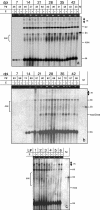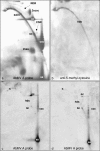Conformation-selective methylation of geminivirus DNA
- PMID: 21835804
- PMCID: PMC3209285
- DOI: 10.1128/JVI.05567-11
Conformation-selective methylation of geminivirus DNA
Abstract
Geminiviruses with small circular single-stranded DNA genomes replicate in plant cell nuclei by using various double-stranded DNA (dsDNA) intermediates: distinct open circular and covalently closed circular as well as heterogeneous linear DNA. Their DNA may be methylated partially at cytosine residues, as detected previously by bisulfite sequencing and subsequent PCR. In order to determine the methylation patterns of the circular molecules, the DNAs of tomato yellow leaf curl Sardinia virus (TYLCSV) and Abutilon mosaic virus were investigated utilizing bisulfite treatment followed by rolling circle amplification. Shotgun sequencing of the products yielded a randomly distributed 50% rate of C maintenance after the bisulfite reaction for both viruses. However, controls with unmethylated single-stranded bacteriophage DNA resulted in the same level of C maintenance. Only one short DNA stretch within the C2/C3 promoter of TYLCSV showed hyperprotection of C, with the protection rate exceeding the threshold of the mean value plus 1 standard deviation. Similarly, the use of methylation-sensitive restriction enzymes suggested that geminiviruses escape silencing by methylation very efficiently, by either a rolling circle or recombination-dependent replication mode. In contrast, attempts to detect methylated bases positively by using methylcytosine-specific antibodies detected methylated DNA only in heterogeneous linear dsDNA, and methylation-dependent restriction enzymes revealed that the viral heterogeneous linear dsDNA was methylated preferentially.
Figures






Similar articles
-
Tomato Yellow Leaf Curl Virus V2 Interacts with Host Histone Deacetylase 6 To Suppress Methylation-Mediated Transcriptional Gene Silencing in Plants.J Virol. 2018 Aug 29;92(18):e00036-18. doi: 10.1128/JVI.00036-18. Print 2018 Sep 15. J Virol. 2018. PMID: 29950418 Free PMC article.
-
Differential methylation of the circular DNA in geminiviral minichromosomes.Virology. 2016 Dec;499:243-258. doi: 10.1016/j.virol.2016.09.024. Epub 2016 Oct 4. Virology. 2016. PMID: 27716464
-
In planta cloning of geminiviral DNA: the true Sida micrantha mosaic virus.J Virol Methods. 2010 Feb;163(2):301-8. doi: 10.1016/j.jviromet.2009.10.014. Epub 2009 Oct 28. J Virol Methods. 2010. PMID: 19878698
-
The complete nucleotide sequence of a new bipartite begomovirus from Brazil infecting Abutilon.Arch Virol. 2010 May;155(5):813-6. doi: 10.1007/s00705-010-0647-7. Epub 2010 Mar 28. Arch Virol. 2010. PMID: 20349251
-
A Novel DNA Motif Contributes to Selective Replication of a Geminivirus-Associated Betasatellite by a Helper Virus-Encoded Replication-Related Protein.J Virol. 2015 Dec 9;90(4):2077-89. doi: 10.1128/JVI.02290-15. Print 2016 Feb 15. J Virol. 2015. PMID: 26656709 Free PMC article.
Cited by
-
Multifunctional roles of geminivirus encoded replication initiator protein.Virusdisease. 2019 Mar;30(1):66-73. doi: 10.1007/s13337-018-0458-0. Epub 2018 Jun 9. Virusdisease. 2019. PMID: 31143833 Free PMC article.
-
A VIGS screen identifies immunity in the Arabidopsis Pla-1 accession to viruses in two different genera of the Geminiviridae.Plant J. 2017 Dec;92(5):796-807. doi: 10.1111/tpj.13716. Epub 2017 Oct 24. Plant J. 2017. PMID: 28901681 Free PMC article.
-
Arabidopsis double-stranded RNA binding protein DRB3 participates in methylation-mediated defense against geminiviruses.J Virol. 2014 Mar;88(5):2611-22. doi: 10.1128/JVI.02305-13. Epub 2013 Dec 18. J Virol. 2014. PMID: 24352449 Free PMC article.
-
Integrated single-base resolution maps of transcriptome, sRNAome and methylome of Tomato yellow leaf curl virus (TYLCV) in tomato.Sci Rep. 2019 Feb 27;9(1):2863. doi: 10.1038/s41598-019-39239-6. Sci Rep. 2019. PMID: 30814535 Free PMC article.
-
DNA Virus Vectors for Vaccine Production in Plants: Spotlight on Geminiviruses.Vaccines (Basel). 2014 Aug 5;2(3):642-53. doi: 10.3390/vaccines2030642. Vaccines (Basel). 2014. PMID: 26344750 Free PMC article. Review.
References
-
- Abouzid A. M., Frischmuth T., Jeske H. 1988. A putative replicative form of the abutilon mosaic virus (gemini group) in a chromatin-like structure. Mol. Gen. Genet. 212: 252–258
-
- Alberter B., Rezaian A. M., Jeske H. 2005. Replicative intermediates of ToLCV and its satellite DNAs. Virology 331: 441–448 - PubMed
-
- Bian X.-Y., Rasheed M. S., Seemanpillai M., Rezaian A. 2006. Analysis of silencing escape of tomato leaf curl virus: an evaluation of the role of DNA methylation. Mol. Plant Microbe Interact. 19: 614–624 - PubMed
-
- Bird A. 2002. DNA methylation patterns and epigenetic memory. Genes Dev. 16: 6–21 - PubMed
Publication types
MeSH terms
Substances
LinkOut - more resources
Full Text Sources
Miscellaneous

